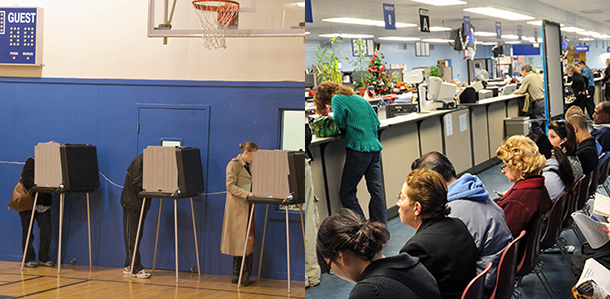
(Photo Credit: Steve Rhodes/Gabriel White/Flickr)
Californians, including the estimated 6.6 million eligible Californians who aren’t registered, will soon have fewer excuses for not registering to vote.
Governor Brown signed a landmark measure into law over the weekend that will allow eligible Californians to be automatically registered to vote when they go to the Department of Motor Vehicles office to obtain or renew a driver’s license.
“In a free society, the right to vote is fundamental,” California Secretary of State Alex Padilla, who had sponsored and promoted the bill, said in a statement. “I applaud Governor Brown for his leadership and bold action to increase voter participation in our state.”
Voter turnout, a problem nationally, reared its head last November when just 42 percent of Californians turned out.
A similar “motor voter” bill was passed in Oregon earlier this year.
Making it easier to vote is a first step, but actually inspiring people to vote is another. The Future of California Elections is a collaboration among election officials, civil rights organizations and election reform advocates to examine and address the unique challenges facing California’s election system.
“California’s new law allowing easier voting registration is a positive step for improving voter participation,” said Vince Hall, executive director of FoCE. “Registering to vote is one thing, getting people to actually vote is another which is a focus of our work between now and the 2016 elections.”
Other reform efforts are focusing on improving the voting experience and streamlining Election Day administration. Los Angeles County is one of the nation’s largest and most complex county election jurisdiction in the country with more than 500 political districts and 4.8 million registered voters. Led by the well-regarded Dean Logan, the Registrar-Recorder/County Clerk, county officials are planning to introduce a new, innovative system for voters to cast their ballots.
One feature of the new system is the option for voters to access and mark interactive sample versions of their ballots on their personal computers or mobile devices. Voters can take these sample ballots (which have unique bar codes) to the polls, where they can use touch-screen devices to scan the bar codes and retrieve their selections.
Another question is how election administration is paid for in California. That’s been a focus of work undertaken by California Forward.
California counties operate elections according to prescribed law, but fund their elections in differing ways, including varying revenue sources and formulas.
“Until now, there has been no comprehensive study to explore county election funding models, thus it has been difficult to establish baseline needs,” said Caitlin Maple, research analyst for CA Fwd. “Using data-driven analysis and informed participation from other states, the Election Funding Project will create a list of options for counties to more sustainably fund election administration in California.”

